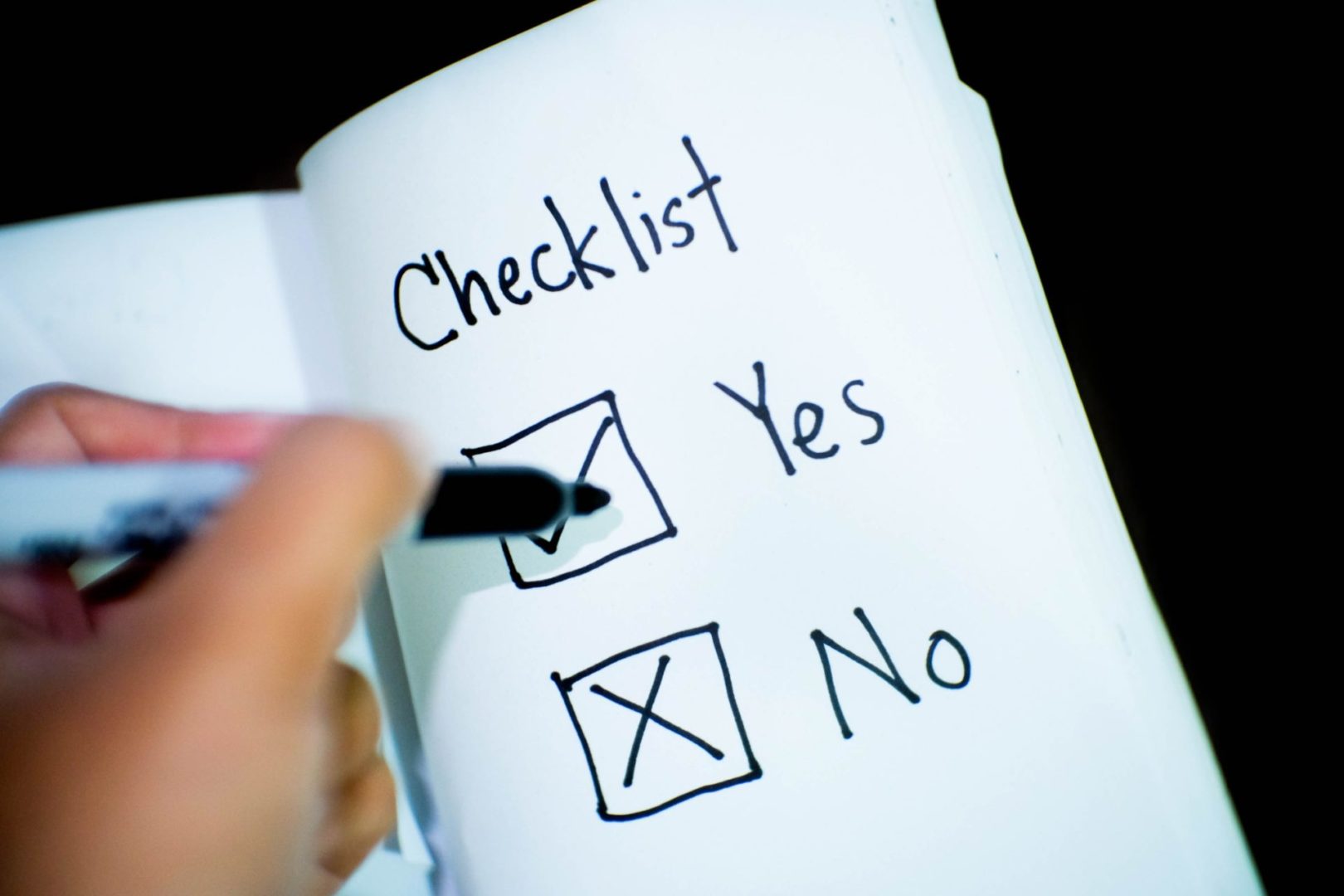Business Startup Checklist
Starting your own business may sound like an undertaking of epic proportions. The truth is, it’s not.
Yes, you’re going to have to work hard, and commit to working on it at all hours of the day, but actually getting set up is simply down to making sure you’ve “checked all the boxes,” which is exactly what this business startup checklist aims to help you do.
We’ve broken the tasks down into manageable categories and included links that will help you complete each stage of getting started.
If you’d like to put yourself through a fast-paced version of the starting a business checklist, be sure to check out our article on Getting a Business Started in 30 Days.
1. Find a good business idea
A good business idea isn’t just one that turns a profit. It’s one that’s a good fit for you personally, for your target market, and for your location. You’re going to be in business for the long haul, so you really should pick something you can live and breathe.
-
- Identify your strengths and weaknesses
- Conduct a SWOT analysis on yourself
- Come up with a business idea that caters to your strengths
- How to start inventing things (or how to find something to invent)
- Define what success looks like for you
- Do your research: What are popular businesses today?
- Identify your strengths and weaknesses
2. Test your business idea and do market research
How do you really know you’ve hit upon something that’s going to work on all levels?
We use the lean planning methodology to figure this out. Of course, you may also want to start by getting out and talking to real people—do they really want a fancy restaurant in their neighborhood or is another coffee shop going to be more to their taste?
-
- Define the “problem” your business is solving
- Summarize the “solution” your business offers
- How urgently do people need what you are selling?
- Will your business continue to be relevant as time passes? How will you adapt?
- Define your target market
- Define your ideal customer
- What’s your market size?
- How easy is it to acquire a customer, and how much will it cost?
- Figure out the best place to set up shop
- What advantages does your solution have over your competitors?
- How much money and effort will it cost to deliver value?
- Do you know your industry?
- Outline the team that will help you execute your idea
- What key responsibilities will each team member have?
- Will team members share ownership of the business?
- Create a basic financial plan
- What up-front investment will you need before you can begin?
- Estimate your basic expenses and forecast sales to ensure that you can make a profit with your business
- Map out business milestones or goals and when you plan to achieve them
- How long will it take to get to market?
- Validate your idea
- Interview potential customers to ensure that they have the problem you are trying to solve
- Interview potential customers to validate that your solution is something your customers will pay for
- Determine if your initial price points will work for your customers
* While we advise students and new entrepreneurs to do market research before they start, we’d like to clarify that you should not let “doing market research” hold you up if you already know your market.
The reality is, the vast majority of real startups are driven by people who know their market from experience and who are ready to bet the farm on it! Market research does not have to be a part of the business planning process. According to Tim Berry, “If you know your market, move on!”

3. If you’re seeking funding, you may need a formal business plan
While you don’t need a 40-page business plan in order to get your business up and running, if you’re seeking funding, institutions like banks may ask for one.
In this case, you can ask if a “one-page pitch” (also known as a one-page business plan) will suffice, or if they’d like a traditional business plan with a detailed financial section (this is the part they pay most attention to).
Complete each of the plan’s sections, as listed below:
-
- Write your executive summary
- Write the company overview
- List your products and services and the problems they are solving or needs they are fulfilling
- Flesh out your target market details
- Create a marketing and sales plan
- Outline key milestones and metrics
- List your management team
- Create a financial plan
- Include an appendix
- Create an elevator pitch
4. Brand your business
A strong brand is the key to customer loyalty and higher sales. If you think it’s just for big business, think again; a brand is critical for businesses of all shapes and sizes.
This is where all the hard work pays off.
Now you know a bit more about your target audience, you’ve got the opportunity—through your brand—to grab their attention. And of course, to have fun doing it!
-
- Choose a name for your business or choose a brand name you know you can trademark
- Decide on your “brand message,” also known as your unique selling proposition or value proposition
- Develop a tagline
- Identify your brand’s “tone of voice”—the heart and soul of all your written communication, your voice is what you say and how you say it
- Define what your brand looks like
- Choose a color scheme
- Choose your fonts
- Create a logo
5. Make it legal
Before you can open shop and comfortably start doing business, you’ve got to make sure you’ve checked all the necessary boxes. Have you registered your business name? Applied for local/county licenses? Obtained statutory employer Identification (KRA/NSSF/NHIF) Numbers? You are going to have to do some things “by the book.”
-
- Decide on a legal structure or business structure
- Register your business name
- Register for a domain name that matches your business name
- File for trademark protection if you will use your business name to identify a product or service
- Obtain any federal and state licenses or permits that you need
- Obtain your Kenya Revenue Authority (KRA) Personal Identification Number (PIN)
- Find a lawyer if you think you may need help.
6. Get financed (only if you need it)
While not every startup needs outside funding, most businesses do require some help, at least at the beginning. There are venture capital firms like antler who can help with startup costs. If you’ve worked through your business plan and have a sound handle on your financials, pitching for funding should be a breeze, whether it’s to friends, family or an investor.
-
- Estimate your startup costs
- Decide whether you will use personal finances, loans, investor money, money from friends and family, crowd-sourced finances, or perhaps something alternative…
- Prepare the relevant financial statements
- Sales forecast
- Profit and loss statement
- Cash flow statement
- Balance sheet
- Refine your elevator pitch for investors
- Apply for financing
- Open a business bank account
- Set up an accounting system
- Know your exit strategy
* It’s worth noting at the point that not all startups need financing.
The vast majority of service startups can use planning to stay on track, but don’t really need funding. If you’re a freelance writer, a designer, a management consultant, a business plan writer, or anyone else making use of a skill that doesn’t need a lot of money behind it, just get started.
7. Set up shop
You’re almost ready to go; just a few more details to work though. Once you’ve found your business location, or set up an office, and set the hiring motions in process, you’ll be ready to begin marketing.
-
- Find a business location
- Decide whether or not to extend credit to your customers
- If you plan to do so, establish a credit policy
- Purchase insurance (the type of insurance you’ll need will vary depending on your business)
- Workers’ compensation insurance
- General liability insurance
- Property or casualty coverage
- Healthcare insurance
- Define your staffing needs
- Do you need full-time, part-time, or freelance employees?
- Draft job descriptions
- Post advertisements for the jobs
- Interview employees
- Hire employees
- Set up your technology
- Point of sale (POS) systems
- Customer Relationship Management (CRM) system
- Billing and payment systems
- Accounting
- Phone systems
8. Market and launch your business
It’s time to start getting people hyped up about your opening day.
This is your opportunity to get things going with a bang! If you give yourself enough time, the press may ask to run a story on you, and of course, you’ll be able to spread the word yourself, as well as ask others to do their bit getting word out.
-
- Create a marketing plan
- Market your business
- Network, network, network (talk to people!)
- Create your marketing materials
- Shop signs
- Stationery, invoices, and PowerPoints
- Brochures and flyers
- Create a website
- Register a domain name (if you didn’t do this when you first registered your business name)
- Purchase hosting
- Build your site
- Get your site listed on key directories
- Get set up on social media platforms
- If necessary, create t-shirts or uniforms
- Let the press know when you’re opening
- Organize an opening day.
Business Startup Checklist
Did you love the story? You can also share YOUR story and get it published on Bizna Click here to get started.




